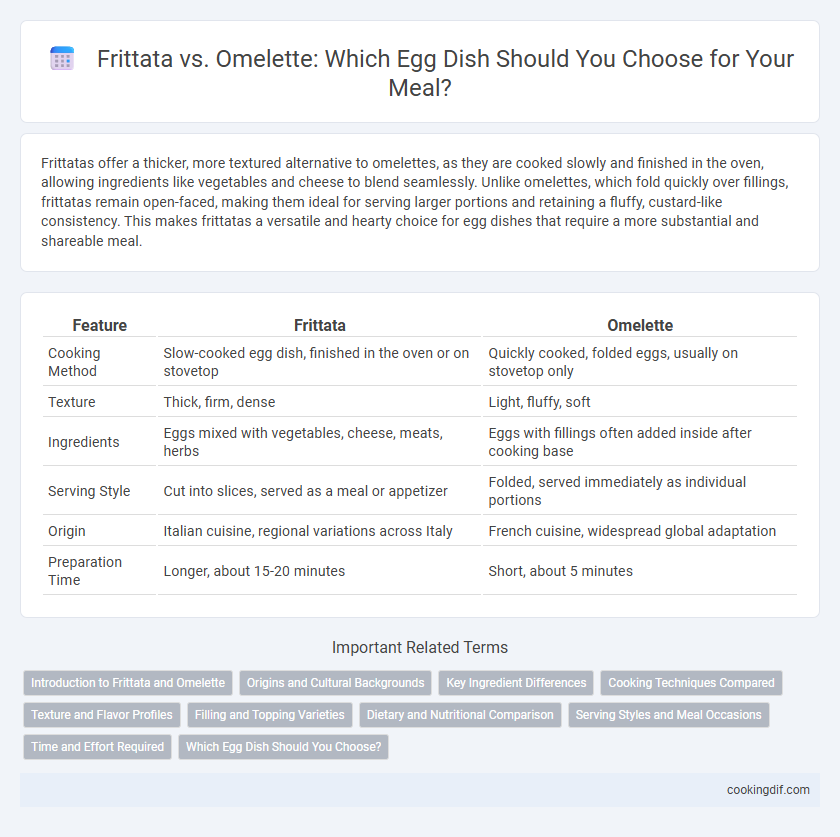Frittatas offer a thicker, more textured alternative to omelettes, as they are cooked slowly and finished in the oven, allowing ingredients like vegetables and cheese to blend seamlessly. Unlike omelettes, which fold quickly over fillings, frittatas remain open-faced, making them ideal for serving larger portions and retaining a fluffy, custard-like consistency. This makes frittatas a versatile and hearty choice for egg dishes that require a more substantial and shareable meal.
Table of Comparison
| Feature | Frittata | Omelette |
|---|---|---|
| Cooking Method | Slow-cooked egg dish, finished in the oven or on stovetop | Quickly cooked, folded eggs, usually on stovetop only |
| Texture | Thick, firm, dense | Light, fluffy, soft |
| Ingredients | Eggs mixed with vegetables, cheese, meats, herbs | Eggs with fillings often added inside after cooking base |
| Serving Style | Cut into slices, served as a meal or appetizer | Folded, served immediately as individual portions |
| Origin | Italian cuisine, regional variations across Italy | French cuisine, widespread global adaptation |
| Preparation Time | Longer, about 15-20 minutes | Short, about 5 minutes |
Introduction to Frittata and Omelette
Frittatas and omelettes are popular egg dishes with distinct preparation methods and textures. Frittatas are thick, open-faced Italian-style egg dishes cooked slowly and finished in the oven, incorporating ingredients like vegetables, cheese, and meats throughout. Omelettes are folded, quickly cooked eggs with fillings added inside, resulting in a light and fluffy texture ideal for individual servings.
Origins and Cultural Backgrounds
Frittata originates from Italy and is deeply rooted in Italian culinary tradition, often incorporating leftover vegetables, cheeses, and meats, reflecting its role as a versatile and resourceful dish. Omelettes trace back to French cuisine, characterized by their fluffy, folded eggs with delicate fillings, emphasizing a quick and elegant preparation method. These distinct origins highlight cultural preferences where frittatas serve as hearty meals, while omelettes are seen as refined, individualized dishes.
Key Ingredient Differences
Frittatas use a larger quantity of beaten eggs mixed with fillings like vegetables, cheese, and meats, which are cooked slowly and finished in the oven, allowing ingredients to blend thoroughly. Omelettes typically utilize fewer eggs, cooked quickly in a pan, with fillings added just before folding, resulting in a lighter, more delicate texture. The primary key ingredient difference lies in the egg-to-filling ratio and cooking method, influencing the dish's density and flavor profile.
Cooking Techniques Compared
Frittatas are cooked slowly over low heat or finished in the oven, allowing the eggs to set evenly and retain a tender, custard-like texture. Omelettes, by contrast, are typically cooked quickly on the stovetop with higher heat, resulting in a folded, soft interior with a lightly browned exterior. The frittata's open-faced style offers room for extensive ingredient mixing, whereas omelettes often contain fillings folded inside after cooking.
Texture and Flavor Profiles
Frittatas offer a dense, custard-like texture with a robust, richer flavor due to the combination of eggs baked slowly with vegetables, cheese, and meats, allowing flavors to meld. Omelettes present a lighter, fluffier texture with a delicate taste, as eggs are quickly cooked and folded around fillings, preserving the distinct flavors of each ingredient. The choice between frittata and omelette significantly influences the mouthfeel and flavor intensity of egg dishes.
Filling and Topping Varieties
Frittatas offer a versatile base for filling varieties, incorporating vegetables, cheeses, and meats directly into the egg mixture, creating a cohesive texture throughout. Omelettes typically feature fillings folded inside, allowing for distinct flavor bursts with toppings like herbs or sauces applied after cooking. The frittata's open-faced presentation accommodates diverse topping options such as fresh greens or grated cheese, enhancing both visual appeal and taste complexity.
Dietary and Nutritional Comparison
Frittatas offer higher protein and fiber content due to the inclusion of vegetables and cheese, making them more nutrient-dense than omelettes. Omelettes often contain fewer calories and fat, as they typically use fewer ingredients and cooking oil. For those seeking sustained energy and nutrient variety, frittatas provide a balanced option, while omelettes are preferable for lighter, lower-calorie meals.
Serving Styles and Meal Occasions
Frittatas are typically served sliced into wedges and enjoyed as a main dish for breakfast, brunch, or light dinner, often served warm or at room temperature. Omelettes, folded and individually portioned, are primarily breakfast staples designed for quick, single servings. The frittata's versatility allows it to be prepared ahead of time and served cold or reheated, making it ideal for casual gatherings and buffet-style meals.
Time and Effort Required
Frittatas require more cooking time, typically 15-20 minutes, as they are cooked slowly over low heat or finished in the oven, allowing ingredients to set evenly. Omelettes cook quickly within 3-5 minutes on the stovetop, demanding more hands-on attention and skill to fold properly. The effort for frittatas is lower during active cooking but needs longer passive cooking time, whereas omelettes require constant maneuvering and fast execution.
Which Egg Dish Should You Choose?
Frittatas offer a thicker, more versatile egg dish compared to omelettes, as they incorporate various fillings mixed directly into the eggs and are cooked slowly, making them ideal for serving multiple people. Omelettes are thinner, folded eggs with fillings added inside, perfect for a quick, individual meal with a delicate texture. Choose frittatas for hearty, shareable breakfasts or brunches with substantial ingredients, whereas omelettes work best for fast, customizable meals with minimal preparation.
Frittata vs Omelette for egg dishes Infographic

 cookingdif.com
cookingdif.com